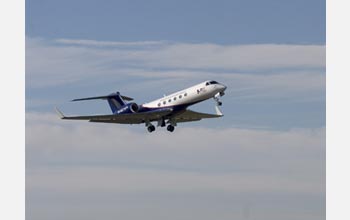|

Media Advisory 09-002
Media Teleconference: HIAPER Returns

Advanced research aircraft returning from historic flight after capturing global snapshot of greenhouse gases
January 27, 2009
HIAPER, one of the nation's most advanced research aircraft, is returning this Friday from the first leg of its historic HIAPER Pole-to-Pole Observations, or HIPPO, mission. The mission has spanned the globe from the Arctic to the Antarctic and provided scientists with new insight into how carbon dioxide, methane and other greenhouse gases are spreading through the multiple layers of Earth's atmosphere. In a teleconference this Thursday, Jan. 29, reporters can discuss the flight with two lead scientists on the project, Steven Wofsy of Harvard University and Britton Stephens of NSF's National Center for Atmospheric Research (NCAR), and also with Pavel Romashkin, NCAR head of Aircraft Operations Support, and Anne-Marie Schmoltner, NSF's Lower Atmospheric Research Section. Additional details about the mission and the teleconference are available at http://www.nsf.gov/hiaper/. For broadcast quality HIAPER b-roll, contact Dena Headlee at dheadlee@nsf.gov. | Who: | Steven Wofsy, Harvard University scientist and principal investigator
Britton Stephens, NCAR scientist and co-principal investigator
Pavel Romashkin, NCAR project manager and head of aircraft operations support
Anne-Marie Schmoltner, NSF section head for lower atmosphere research | | What: | Media teleconference to discuss preliminary findings from the first leg of HIAPER's HIPPO mission. | | When: | 1 p.m. EST, Thursday, Jan. 29, 2009 |
To participate in the teleconference, reporters in the United States should call 1 (800) 735-5968. No passcode is necessary. Reporters dialing in from outside the United States should call (212) 231-2911.
-NSF-

Media Contacts
Joshua A. Chamot, NSF (703) 292-7730 jchamot@nsf.gov
David Hosansky, NCAR/UCAR (303) 497-8611 hosansky@ucar.edu
Rachael Drummond, NCAR/UCAR (303) 497-8604 rachaeld@ucar.edu

The National Science Foundation (NSF) is an independent federal agency that supports fundamental research and education across all fields of science and engineering. In fiscal year (FY) 2009, its budget is $9.5 billion, which includes $3.0 billion provided through the American Recovery and Reinvestment Act. NSF funds reach all 50 states through grants to over 1,900 universities and institutions. Each year, NSF receives about 44,400 competitive requests for funding, and makes over 11,500 new funding awards. NSF also awards over $400 million in professional and service contracts yearly.
 Get News Updates by Email Get News Updates by Email
Useful NSF Web Sites:
NSF Home Page: http://www.nsf.gov
NSF News: http://www.nsf.gov/news/
For the News Media: http://www.nsf.gov/news/newsroom.jsp
Science and Engineering Statistics: http://www.nsf.gov/statistics/
Awards Searches: http://www.nsf.gov/awardsearch/
| 

